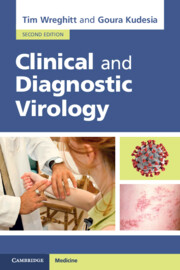Epidemiology
Route of Spread
There are more than 50 different serotypes (each designated by a number) of adenoviruses and several disease syndromes associated with different serotypes. Respiratory adenoviruses are spread by the respiratory route. Enteric adenoviruses (adenovirus 40 and 41) are spread via the faecal-oral route, and adenoviruses causing conjunctivitis are very infectious and spread by direct contamination of the eye. Adenovirus infections in humans are generally caused by adenoviruses types B, C, E and F.
Prevalence
Adenovirus infections affect all ages. Respiratory adenovirus infections occur every year in the community, causing outbreaks in persons of all ages, often in children in schools and other institutions throughout the year. Severe disease is rare in people who are otherwise healthy. Adenovirus infection accounts for up to 10% of respiratory infections in children. Most cases are mild.
Enteric adenoviruses are a cause of sporadic diarrhoea and vomiting, mainly in young children, throughout the year. Although they cause small outbreaks, usually in community settings, they are not associated significantly with large outbreaks of diarrhoea and vomiting in hospitals and cruise ships.
Adenoviruses associated with conjunctivitis occur sporadically, often associated with clusters of cases. They happen throughout the year, and outbreaks can occur particularly in winter and spring, when they may spread more quickly in closed populations such as in hospitals, nurseries, long-term care facilities, schools and swimming pools.
A total of 75% of viral conjunctivitis cases are due to adenovirus infection.
Infectious Period
Patients are infectious while they are symptomatic. Spread occurs mainly when an infected person is in close contact with another person. This may occur by the faecal–oral route, airborne transmission or small droplets containing the virus. Less commonly, the virus may spread via contaminated surfaces.
Clinical
Symptoms
Respiratory adenoviruses cause a range of respiratory symptoms from mild coryza to pneumonia. Clinical symptoms include fever, cough and sore throat due to pharyngitis and tonsillitis. Some infections are asymptomatic. It is difficult to differentiate adenovirus infection from other respiratory virus infections symptomatically, although adenoviruses, unlike influenza viruses, do not usually produce myalgia. Some adenoviruses can also cause a maculopapular rash. Rarely, death occurs due to disseminated adenovirus infection.
Enteric adenoviruses cause diarrhoea, vomiting and fever, particularly in children less than 2 years of age. The diarrhoea lasts for an average of 8 days (range 3–11 days), longer than diarrhoea caused by rotaviruses.
Ocular adenoviruses cause conjunctivitis with red, sore injected conjunctiva. It is a very infectious condition and scrupulous infection control procedures are necessary to prevent spread, particularly by the direct contact route. Large outbreaks have been reported. One famous outbreak called ‘shipyard eye’ occurred in a shipyard in the north of England, when metal workers were treated for metal slivers in their eyes. Contaminated eye instruments were blamed for transmitting the virus.
In the spring of 2022, the UK Health Security Agency identified a growing cluster of acute hepatitis cases in children under the age of 10 years with no association with travel and hepatitis viruses A–E. Of the children, 66% had adenoviruses (adenovirus 41) detected, and a case control study confirmed this association. Some children had severe infection, necessitating liver transplantation. Adenovirus-associated viruses were also found in the majority of cases. Several different factors are thought to be associated with this outbreak, which was not a point source outbreak, with several adenovirus 41 lineages detected.
Immunocompromised Patients
Organ transplant recipients, especially children, infected with respiratory adenoviruses can have measles-like symptoms (e.g. measles-like rash and conjunctivitis but no Koplik’s spots). Bone marrow transplant recipients can experience severe or fatal infection. Enteric adenoviruses can cause prolonged symptoms and viral excretion in transplant recipients, especially children. Many paediatric centres therefore follow their high-risk bone marrow transplant recipients with regular laboratory screens for adenovirus infection. Adenoviruses may cause myocarditis, meningoencephalitis or hepatitis in immunocompromised people.
Laboratory Diagnosis
Several laboratory methods and clinical specimens can be used to diagnose adenovirus infection (Table 1.1). Nucleic acid amplification techniques (NAAT), like polymerase chain reaction (PCR), are the method of choice (although virus culture, immunofluorescence and electron microscopy can be used if available).
Table 1.1 Laboratory diagnosis of adenoviruses
Figure 1.1 shows an electron micrograph of a group of adenoviruses.
Management
Treatment
Aerosolised ribavirin can be given to children with bronchiolitis and intravenous ribavirin can be given (under expert advice) to immunocompromised children. Bone marrow transplant recipients can experience severe and fatal infections and can be treated with cidofivir (see Chapter 54).
Prophylaxis
There is no prophylaxis available. Currently, there is no adenovirus vaccine available to the general public, but a vaccine is available for the United States military for Types 4 and 7. US military personnel are the recipients of this vaccine because they may be at a higher risk of infection because of closer prolonged contact.




